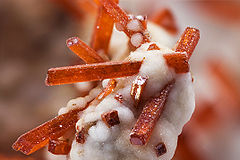- Dundasite
-
Dundasite 
Dundasite (the white mineral) and crocoite from Dundas, Tasmania. Field of view is 5mm.General Category Carbonate mineral Chemical formula PbAl2[(OH)2|CO3]2 • H2O Strunz classification 05.DB.10 Crystal symmetry Orthorhombic dipyramidal H-M Symbol (2/m 2/m 2/m) Space Group: Pbmm Unit cell a = 9.08 Å, b = 16.37 Å, c = 5.62 Å; Z = 4 Identification Color White to very pale blue; colorless in transmitted light Crystal habit Acicular crystals typically in spherical aggregates and matted crusts Crystal system Orthorhombic Cleavage Perfect On {010} Mohs scale hardness 2 Luster Vitreous to silky Streak White Diaphaneity Transparent Specific gravity 3.10 – 3.55 Optical properties Biaxial (-) Refractive index nα = 1.603 nβ = 1.716 nγ = 1.750 Birefringence δ = 0.147 2V angle Measured: 30° to 40°, calculated: 54° References [1][2][3] Dundasite is a rare lead aluminium carbonate mineral. The mineral is named after the type locality, Dundas, Tasmania, Australia.[1] The mineral was first discovered in the Adelaide Proprietary Mine.[4] Dundasite was first described by William Frederick Petterd in 1893.[5]
Dundasite is an uncommon secondary mineral occurring in the oxidized zone of lead ore deposits.[2] It commonly overgrows crocoite. It may also be overgrown by yellow cerussite.[4] It may be associated with cerussite, plattnerite, azurite, malachite, pyromorphite, mimetite, beudantite, duftite, crocoite, gibbsite, allophane and limonite.[2]
Besides its type location on Tasmania, the mineral has also been found in New Zealand, Australia, China, Belgium, Germany, France, Greece, United Kingdom, Ireland, Italy, Austria, Czech Republic, Namibia, and the USA.[1]
References
 Media related to Dundasite at Wikimedia Commons
Media related to Dundasite at Wikimedia Commons- ^ a b c "Dundasite mineral information and data". mindat.org. http://www.mindat.org/min-1330.html. Retrieved May 2011.
- ^ a b c "Handbook of Mineralogy: Dunasite". RRUF Database. http://rruff.geo.arizona.edu/doclib/hom/dundasite.pdf. Retrieved May 2011.
- ^ "Dundasite Mineral Data". Webmineral. http://www.webmineral.com/data/Dundasite.shtml. Retrieved May 2011.
- ^ a b Bottrill, Ralph (April 12, 2009). "Dundasite". http://www.mindat.org/forum.php?read,70,134092,134295. Retrieved 2009-10-16.
- ^ "Volume 14". The Mineralogical magazine and journal of the Mineralogical Society (Great Britain: Mineralogical Society). 1965.
This article about a specific carbonate mineral is a stub. You can help Wikipedia by expanding it.
